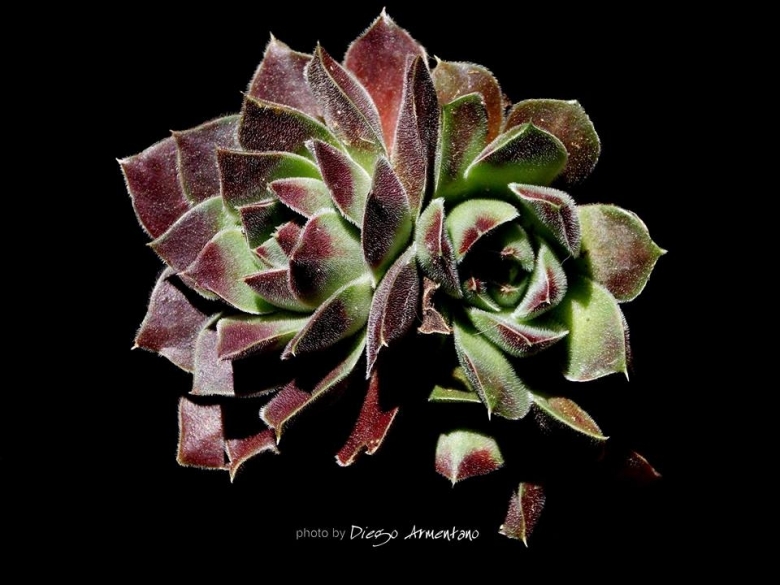
Sempervivum heuffelii Photo by: Diego Armentano
Origin and Habitat: East Europe (East Carpathians and mountain of the Balkan peninsula), Albania, Bulgaria, Greece, Serbia, Romania. Sempervivum heuffeliiSN|32611]]SN|32611]] (Jovibarba heuffeliiSN|32613]]SN|32613]]) is escaped from cultivation in the United States and is now a naturalized weed in Ashland County, northern Wisconsin. It has been introduced elsewhere.
Altitude range: 0-1000 metres above sea level.
Habitat and ecology. This species dwells on rock outcrops, cliffs and stony hills of the montane zone. It is a calcicole (lime lover) plant that, but in exceptional cases it can also be found in siliceous substrates.
Synonyms:
See all synonyms of Sempervivum heuffelii
back
Accepted name in llifle Database:Sempervivum heuffelii SchottOesterr. Bot. Wochenbl. 2: 18 1852Synonymy: 26
back
Common Names include:
ENGLISH: Job's Beard
GERMAN (Deutsch): Balkan-Fransenhauswurz
Description: Sempervivum heuffeliiSN|32611]]SN|32611]], is a perennial succulent herb with leaves in rosettes, producing flowers once only. In 1961 Á.Löve & D.Löve proposed to place this species into the small genus Jovibarba, because instead of having stolons (runners), the green or blue-green, sometimes red-flushed rosettes split into two. Moreover Sempervivum heuffeliiSN|32611]]SN|32611]] is distinguished by the 6-merous (rarely 5- or 7-merous), campanulate flowers with pale yellow, dorsally keeled petals. This species is quite variable, especially in the degree of pubescence as well as in the size and coloration of the leaves. The glabrous form appears to be more common.
Derivation of specific name: This member of the Crassulaceae family was given the name 'heuffelii' in honours of Johann A. Heuffel (1800–1857), Hungarian physician and botanist.
Rosettes: (0.5-)5-7(-12) cm in diameter, closed to somewhat open, globose, with patent leaves (soon diverging from the axis almost at right angles). Stolons absent and producing offsets attached directly to primary roots.
Leaves: Alternate, fleshy, not deciduous. Blade 25-60 mm long, 10-15 mm broad, oblong-obovate,both faces convex, apex spinose-mucronate, surfaces usually glabrous, dark or glaucous green, margins sometimes ciliate with stiff, often reflexed hairs.
Inflorescences : 7-20 cm tall erect, usually densely ca. 12-40-flowered, bracteate. Leaves with broad clasping base, lanceolate, acuminate, purple-tipped, 10 - 30 mm long.Dichasia compact, 3-5 cm in diameter. Rachis 5-15(-20) cm, glabrous. Bracts 1 per flower, clasping at base, lanceolate, 1-3 cm, base broad.
Flowers: Sepals glandular-ciliate. Petals 10-12 mm, oblong-obovate, usually tricuspidate, ciliate but scarcely fimbriate, keeled, but not dorsally winged. Filaments pale yellow, anthers deep yellow. Styles 2 mm, relatively stout. Nectaries square to rounded, greenish.
Blooming season: Mid summer-autumn.
Seeds: Pear-shaped, with small wing on the apex, base narrowed with hilum, 0.9-1.1 x 0.5-0.6 mm. Surface with numerous longitudinal ribs, shining, pale-brown.
Chromosome number: 2n = 38.
Bibliography: Major references and further lectures
1) Urs Eggli “Illustrated Handbook of Succulent Plants: Crassulaceae: Crassulaceae” Springer Science & Business Media, 01 January 2003
2) T. G. Tutin “Flora Europaea: Psilotaceae to Platanaceae” Cambridge University Press, 22 April 1993
3) Arne Strid “Mountain Flora of Greece”, Volume 1 CUP Archive, 03 April 1986
4) Vít Bojnanský, Agáta Fargašová “Atlas of Seeds and Fruits of Central and East-European Flora: The Carpathian Mountains Region” Springer Science & Business Media, 17
5) “Jovibarba heuffelii (Schott) Á. Löve & D. Löve” in Flora of North-America @ efloras.org <http://www.efloras.org/florataxon.aspx?flora_id=1&taxon_id=250092049> FNA Vol. 8 Page 170, 171.
6) Reader's Digest Association “A-Z of rock garden & water plants” Reader's Digest Association, 01 December 1995
7) Peter Bernhardt “Gods and Goddesses in the Garden: Greco-Roman Mythology and the Scientific Names of Plants” Rutgers University Press, 11 March 2008
8) Martin Haberer, Hans Graf “500 winterharte Sukkulenten und Kakteen von A – Z.” Stuttgart 2010
9) Urs Eggli, Leonard E. Newton “Etymological Dictionary of Succulent Plant Names” Springer, Berlin/Heidelberg 2010
Cultivation and Propagation: Sempervivum heuffeliiSN|19333]]SN|32611]] (Jovibarba heuffeliiSN|32613]]SN|32613]]) is an interesting plant and very easy to grow in container or in the rock garden. It grows well in any position where the common Houseleek (Sempervivum tectorumSN|32611]]SN|19333]]) may be grown.
Soil: Although it grows on limestone substrata, it does not seem fussy about conditions in the garden. Require a well drained succulent soil mix. Outdoors it will spread itself through narrow locations between rockery stones. It does not prefer rich loamy soil; gritty dirt with pea gravel suits it.
Watering: It takes little water & could rot if watered too often. During the growing season, the plants are watered and allowed to dry slightly before watering again. Although they can take a great deal of drought, they seem to do better with regular (but moderated) watering. During the winter months, plants are watered very little.
Exposition: It need full sun to light shade and tolerates shade, but a sunny spot is nicest, though in warmer climates it needs protection from too much sun because it is not very heat tolerant.
Frost Tolerance: Hardy at least to -12°C (or less).
Uses: It is choicest species for the rock-garden and borders, it can be used for edgings, lines and panels in the flower garden, and naturalized on walls, ruins, or any position where the Common Houseleek thrives.
Propagation: Is very easily propagated by new rosettes arising by division of old ones, and not as offsets.










